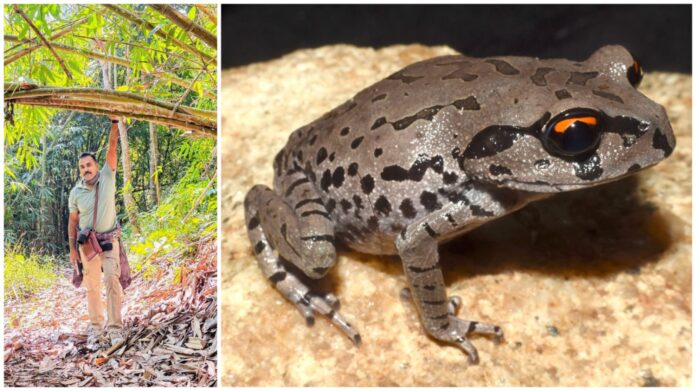GUWAHATI, April 14: In a captivating blend of science and sentiment, researchers have uncovered a new species of frog in the lush Garbhanga Reserve Forest near Guwahati, Assam. Dubbed Leptobrachium aryatium, the species has been named in honour of Arya Vidyapeeth College, a renowned academic institution in the city that played a foundational role in the lives of the scientists behind the discovery.
The frog, distinguished by its striking orange-and-black eyes, reticulated throat pattern, and soft, rhythmic dusk-time calls, marks a significant addition to India’s amphibian biodiversity. Through meticulous analysis of its physical traits, genetic markers, and vocalization patterns, scientists confirmed it to be a species previously unknown to science.
The naming of Leptobrachium aryatium is deeply personal for the research team — Dr. Jayaditya Purkayastha, Dr. Dipankar Dutta, Dr. Jayanta Gogoi, and Dr. Saibal Sengupta — all of whom have academic ties to Arya Vidyapeeth College. “This is our tribute to an institution that nurtured our curiosity and shaped our scientific journeys,” said Dr. Purkayastha.

A forest treasure under threat
The frog was discovered deep within the Garbhanga Reserve Forest, a vibrant green expanse that acts as a crucial ecological buffer for Guwahati. Home to elephants, rare birds, butterflies, and now L. aryatium, Garbhanga is facing increasing pressure from rapid urban expansion and habitat degradation. Scientists and conservationists alike hope this discovery will draw renewed attention to the forest’s ecological importance.
Leptobrachium aryatium is a nocturnal species primarily active during the monsoon months from April to August. It prefers the leaf-littered undergrowth of moist deciduous and sal forests, often found near slow-moving hill streams — vital for its breeding rituals. Males use a unique series of calls to attract females, leading to a ritualistic mating dance that culminates in egg-laying within side pools of forest streams.

The frog’s tadpoles inhabit nearly stagnant water pockets and display a swift escape response, burrowing into sandy stream beds at the slightest disturbance. The species’ life cycle and microhabitat preferences highlight the delicate ecological balance required for its survival.
Regional and scientific significance
Though its closest relatives have been reported in parts of Meghalaya, Manipur, and Mizoram, researchers currently limit the confirmed distribution of L. aryatium to select forest areas in Kamrup and Ri-Bhoi districts, including Garbhanga, Amchang Wildlife Sanctuary, and Nongkhyllem Wildlife Sanctuary.

The discovery also has broader implications for amphibian taxonomy in Northeast India. It calls into question earlier identifications of Leptobrachium smithi in the region, suggesting that many of those specimens may actually belong to L. aryatium or L. sylheticum — a species described in recent years from Bangladesh and Tripura. The authors advocate for a re-evaluation of faunal records using both molecular and morphological methods to avoid misidentification.
A call for conservation and continued exploration
The identification of Leptobrachium aryatium is a reminder of the rich yet understudied biodiversity in the forests of Northeast India. It reinforces the critical need for conservation, precise taxonomy, and sustained field research to protect such species — many of which may still be hiding, unseen, in the leaf litter.
As the scientific community celebrates this vibrant new addition to the amphibian family, it also shines a light on a cherished academic institution and a threatened forest — both of which play a role in the survival of knowledge, heritage, and life itself.
Read: Meghalaya targets to complete all smart city projects by mid-2026
WATCH:
Find latest news from every corner of Northeast India at hubnetwork.in, your online source for breaking news, video coverage.
Also, Follow us on-
Twitter-twitter.com/nemediahub
Youtube channel- www.youtube.com/@NortheastMediaHub2020
Instagram- www.instagram.com/ne_media_hub
Download our app from playstore – Northeast Media Hub






